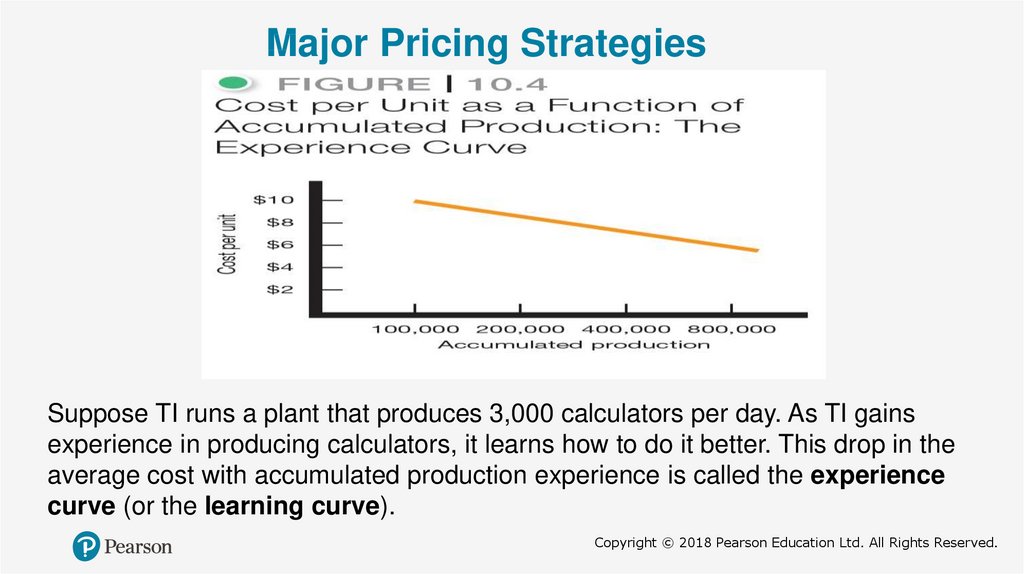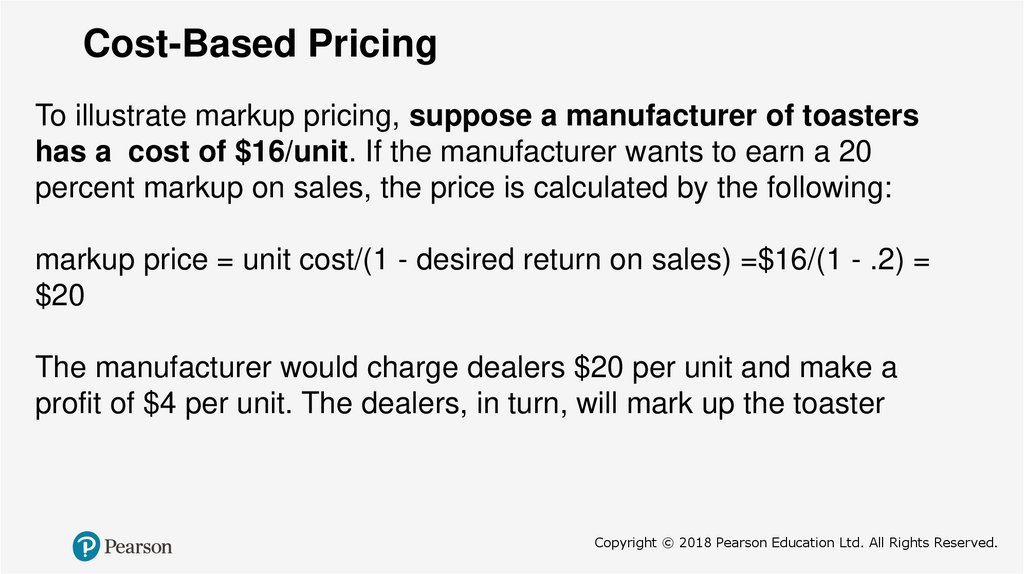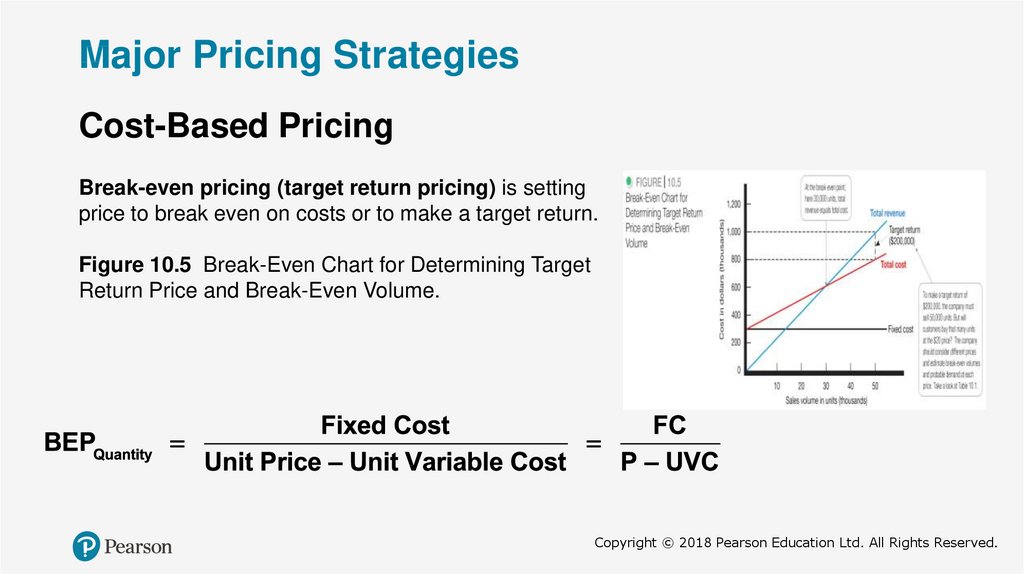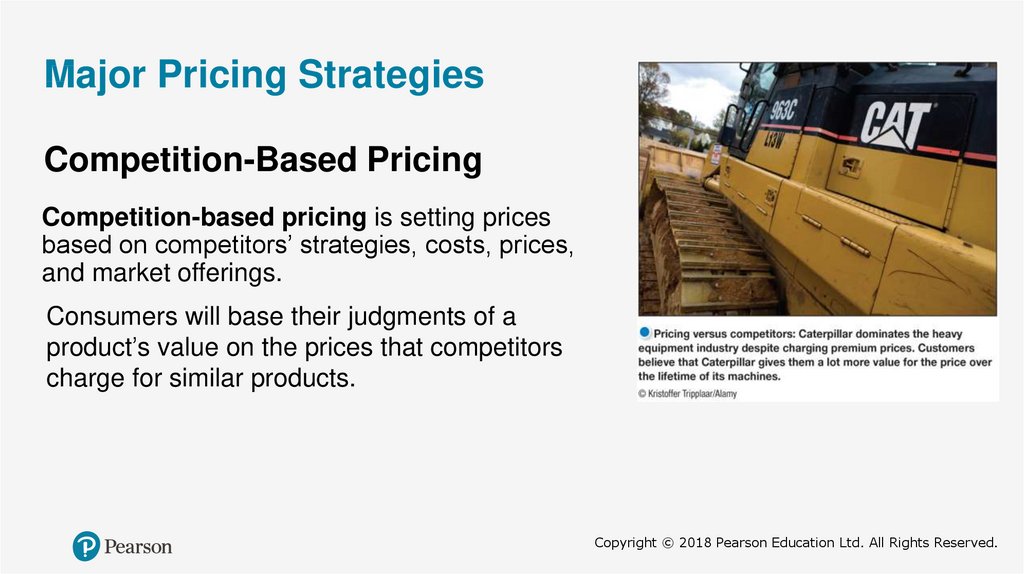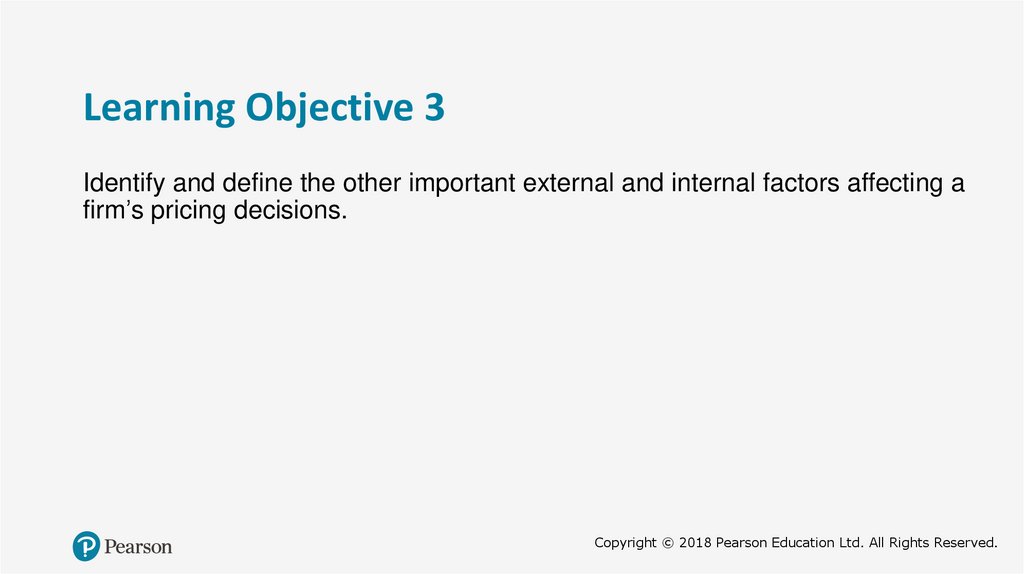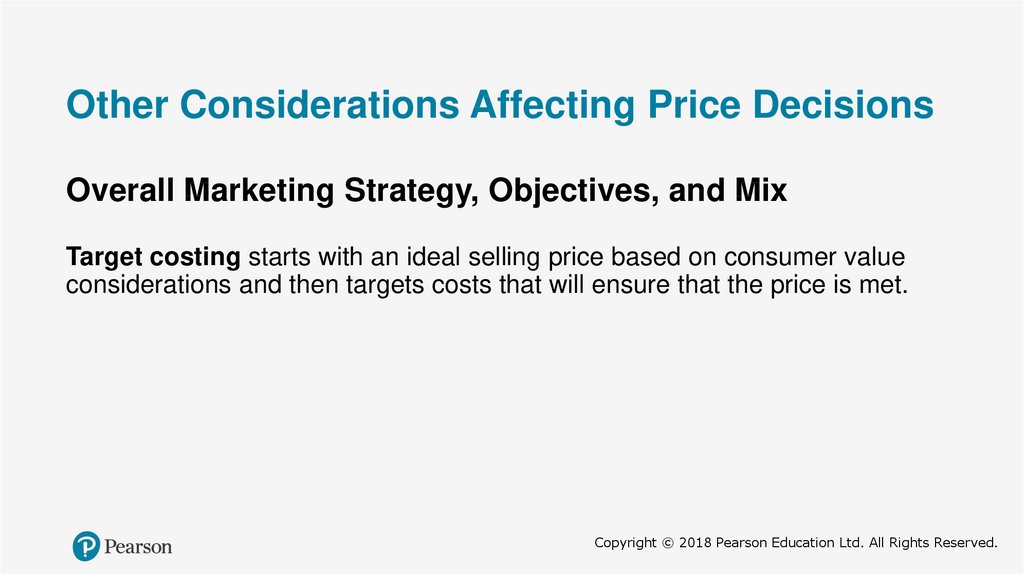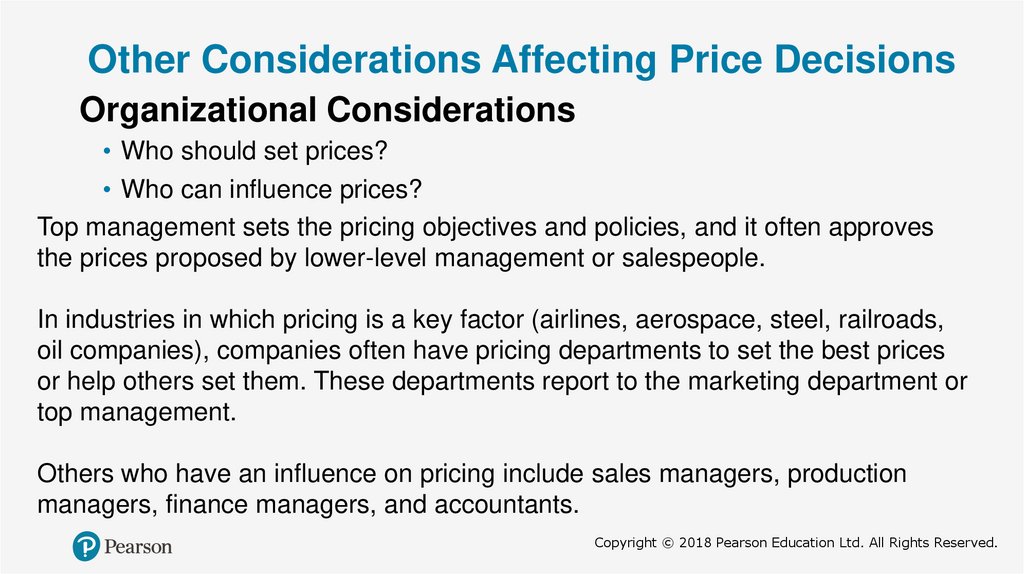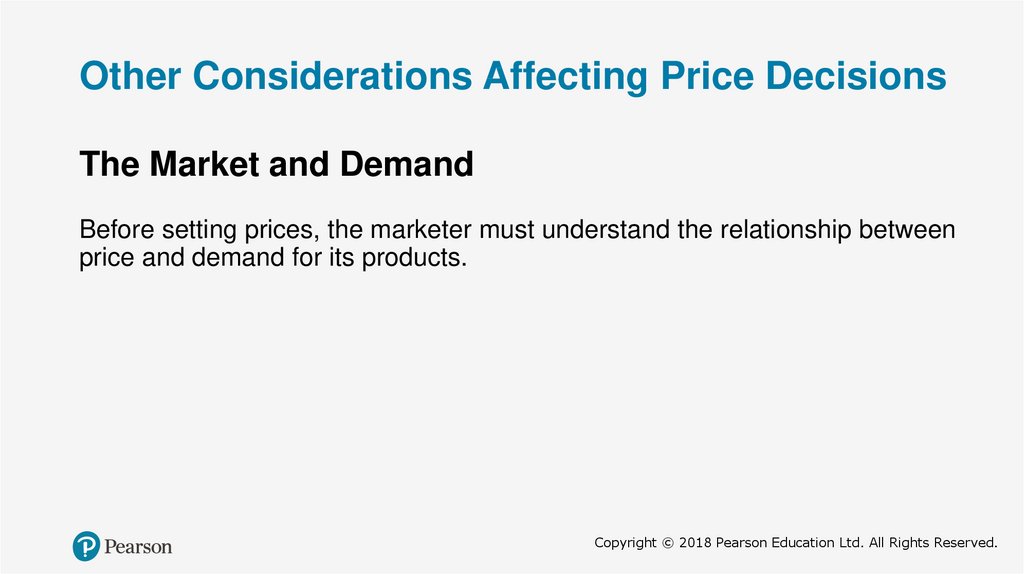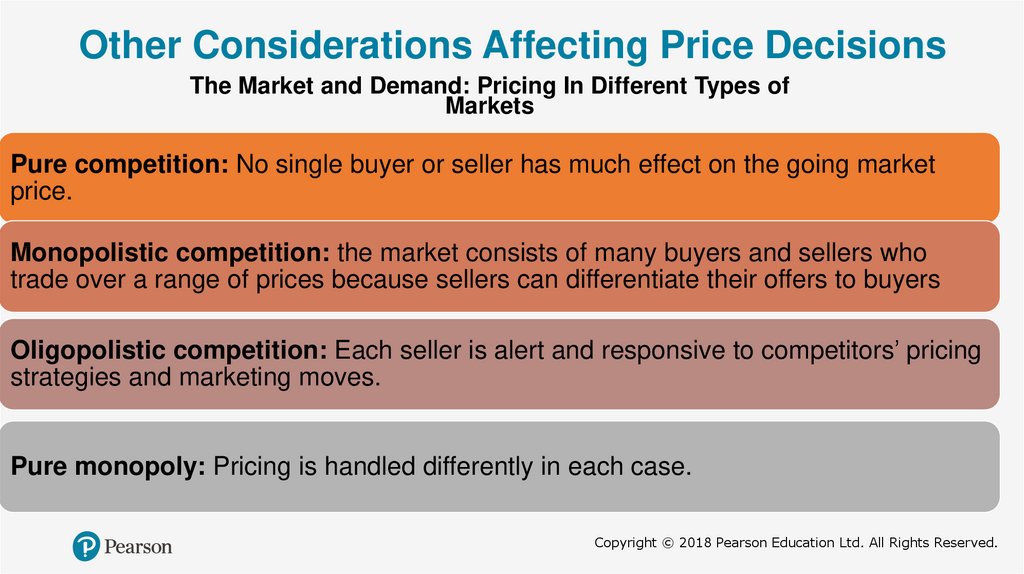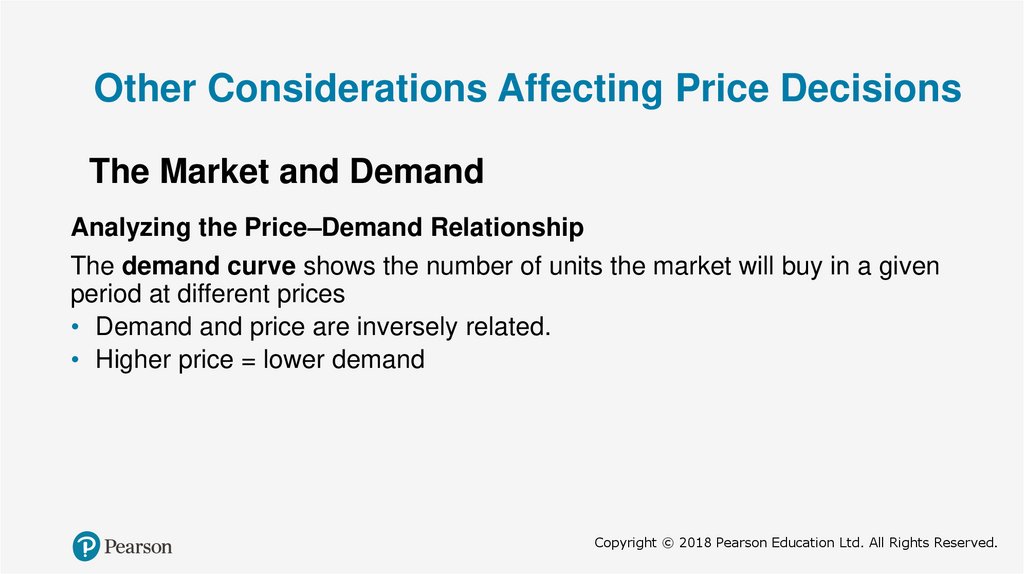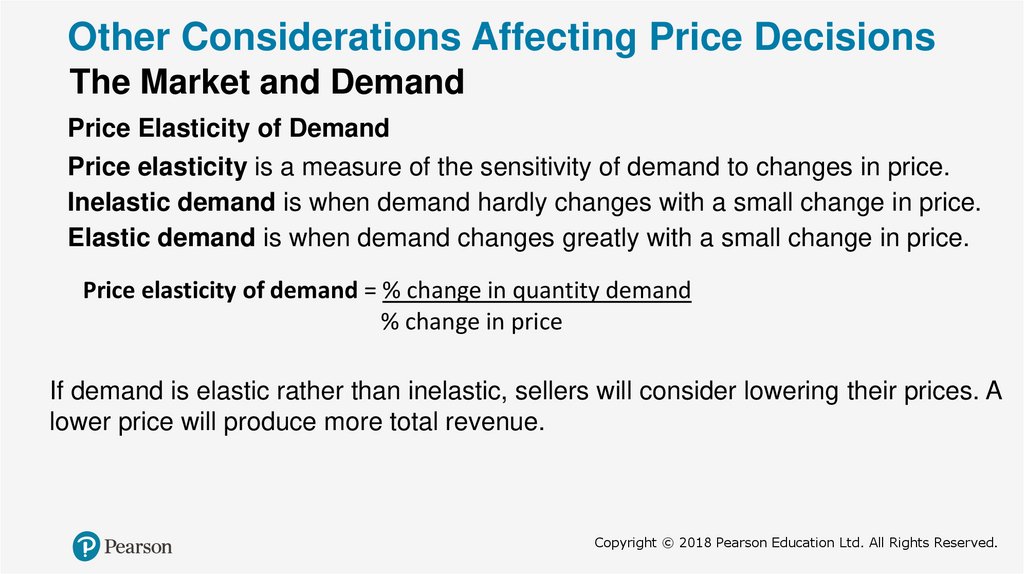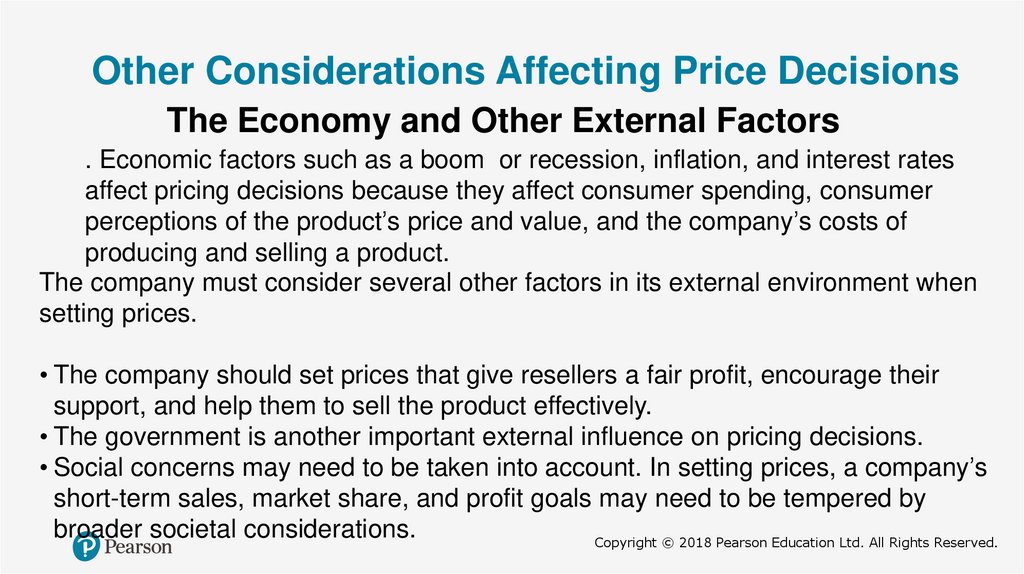Похожие презентации:
kotler_pom17e_ppt_10
1.
Principles of MarketingSeventeenth Edition
Chapter 10
Pricing: Understanding and
Capturing Customer Value
Copyright © 2018 Pearson Education Ltd. All Rights Reserved.
2.
Learning Objectives10-1 Answer the question “What is a price?” and discuss the importance of
pricing in today’s fast-changing environment.
10-2 Identify the three major pricing strategies and discuss the importance of
understanding customer-value perceptions, company costs, and
competitor strategies when setting prices.
10-3 Identify and define the other important external and internal factors
affecting a firm’s pricing decisions.
Copyright © 2018 Pearson Education Ltd. All Rights Reserved.
3.
Learning Objective 1Answer the question “What is a price?” and discuss the importance of pricing
in today’s fast-changing environment.
Copyright © 2018 Pearson Education Ltd. All Rights Reserved.
4.
What Is a Price?Price is the amount of money charged for a product or service, or the sum of all the
values that customers exchange for the benefits of having or using the product or
service.
Copyright © 2018 Pearson Education Ltd. All Rights Reserved.
5.
Learning Objective 2Identify the three major pricing strategies and discuss the importance of
understanding customer-value perceptions, company costs, and competitor
strategies when setting prices.
Copyright © 2018 Pearson Education Ltd. All Rights Reserved.
6.
Major Pricing Strategies• Figure 10.1 suggests three major pricing strategies: customer valuebased pricing, cost-based pricing, and competition-based pricing.
The price the company charges will fall somewhere between one that is too low to
produce a profit and one that is too high to produce any demand.
Figure 10.1 summarizes the major considerations in setting price. Customer
perceptions of the product’s value set the ceiling for prices. Likewise, product costs set
the floor for a product’s price.
In setting its price between these two extremes, the company must consider several
external and internal factors, including competitors’ strategies and prices, the overall
marketing strategy and mix, and the nature of the market and demand.
Copyright © 2018 Pearson Education Ltd. All Rights Reserved.
7.
Major Pricing StrategiesCopyright © 2018 Pearson Education Ltd. All Rights Reserved.
8.
Major Pricing StrategiesCustomer Value-Based Pricing
Value-based pricing uses the buyers’ perceptions of value rather than the
seller’s cost.
• Value-based pricing is customer driven.
• Cost-based pricing is product driven.
• Price is set to match perceived value.
Copyright © 2018 Pearson Education Ltd. All Rights Reserved.
9.
Major Pricing StrategiesCopyright © 2018 Pearson Education Ltd. All Rights Reserved.
10.
Major Pricing StrategiesCustomer Value-Based Pricing
There are two types of Value-Based Pricing: Goodvalue pricing and added-value pricing
Good-value pricing is offering just the right combination of
quality and good service at a fair price.
In many cases, this has involved introducing less-expensive versions of
established brand name products or new lower-price lines.
In other cases, good-value pricing has involved redesigning existing brands to offer more
quality for a given price or the same quality for less. Some companies even succeed by
offering less value but at very low prices.
An important type of Good-value pricing at the retail level is called everyday low pricing
ALDI practices everyday low pricing (EDLP). The king of EDLP is Walmart, which practically
defined the concept. In contrast to High-low pricing.
Copyright © 2018 Pearson Education Ltd. All Rights Reserved.
11.
Major Pricing StrategiesCustomer Value-Based Pricing
Good-value pricing
Everyday low pricing (EDLP) involves charging a constant everyday low price
with few or no temporary price discounts.
Good-value pricing: ALDI keeps costs low so that it can offer customers “impressively high
quality at impossibly low prices” every day.
Copyright © 2018 Pearson Education Ltd. All Rights Reserved.
12.
Major Pricing StrategiesCustomer Value-Based Pricing
Good-value pricing
High-low pricing involves charging higher prices on an everyday basis but
running frequent promotions to lower prices temporarily on selected items.
Department stores such as Sears and Macy’s practice
high-low pricing by having frequent sale days, early-bird
savings, and bonus earnings for store credit-card holders.
Copyright © 2018 Pearson Education Ltd. All Rights Reserved.
13.
Major Pricing StrategiesCustomer Value-Based Pricing
Value-based pricing doesn’t mean simply charging what customers want to pay or
setting low prices to meet competition. Instead, many companies adopt valueadded pricing strategies. Rather than cutting prices to match competitors, they
add quality, services, and value-added features to differentiate their offers and thus
support their higher prices.
Copyright © 2018 Pearson Education Ltd. All Rights Reserved.
14.
Major Pricing StrategiesCost-Based Pricing
Cost-based pricing sets prices based on the costs for producing, distributing, and
selling the product plus a fair rate of return for effort and risk.
Whereas customer-value perceptions set the price ceiling, costs set the floor for the
price that the company can charge.
Some companies, such as Walmart or Southwest Airlines, work to become the lowcost producers in their industries. Companies with lower costs can set lower prices
that result in smaller margins but greater sales and profits.
Copyright © 2018 Pearson Education Ltd. All Rights Reserved.
15.
Major Pricing StrategiesCost-Based Pricing
Types of costs
Fixed costs (also known as overhead) are costs that do not vary with
production or sales level.
Rent
Heat
Interest
Executive salaries
Copyright © 2018 Pearson Education Ltd. All Rights Reserved.
16.
Major Pricing StrategiesCost-Based Pricing
Variable costs vary directly with the level of production.
• Raw materials
• Packaging
Variable costs vary directly with the level of production. Each PC
produced by HP involves a cost of computer chips, wires, plastic,
packaging, and other inputs. Although these costs tend to be the
same for each unit produced, they are called variable costs because
the total varies directly with the number of units produced.
Copyright © 2018 Pearson Education Ltd. All Rights Reserved.
17.
Major Pricing StrategiesCost-Based Pricing
Total costs are the sum of the fixed and variable costs for any given level of
production.
Management wants to charge a price that will at least cover the total
production costs at a given level of production.
Copyright © 2018 Pearson Education Ltd. All Rights Reserved.
18.
Major Pricing StrategiesCopyright © 2018 Pearson Education Ltd. All Rights Reserved.
19.
Major Pricing StrategiesSuppose TI runs a plant that produces 3,000 calculators per day. As TI gains
experience in producing calculators, it learns how to do it better. This drop in the
average cost with accumulated production experience is called the experience
curve (or the learning curve).
Copyright © 2018 Pearson Education Ltd. All Rights Reserved.
20.
Major Pricing StrategiesCost-Based Pricing
Cost-plus pricing adds a standard markup to the cost of the product.
• Benefits
Sellers are certain about costs.
Price competition is minimized.
Buyers feel it is fair.
• Disadvantages
Ignores demand and competitor prices
Copyright © 2018 Pearson Education Ltd. All Rights Reserved.
21.
Cost-Based PricingTo illustrate markup pricing, suppose a manufacturer of toasters
has a cost of $16/unit. If the manufacturer wants to earn a 20
percent markup on sales, the price is calculated by the following:
markup price = unit cost/(1 - desired return on sales) =$16/(1 - .2) =
$20
The manufacturer would charge dealers $20 per unit and make a
profit of $4 per unit. The dealers, in turn, will mark up the toaster
Copyright © 2018 Pearson Education Ltd. All Rights Reserved.
22.
Major Pricing StrategiesCost-Based Pricing
Break-even pricing (target return pricing) is setting
price to break even on costs or to make a target return.
Figure 10.5 Break-Even Chart for Determining Target
Return Price and Break-Even Volume.
Copyright © 2018 Pearson Education Ltd. All Rights Reserved.
23.
Major Pricing StrategiesCopyright © 2018 Pearson Education Ltd. All Rights Reserved.
24.
Major Pricing StrategiesCompetition-Based Pricing
Competition-based pricing is setting prices
based on competitors’ strategies, costs, prices,
and market offerings.
Consumers will base their judgments of a
product’s value on the prices that competitors
charge for similar products.
Copyright © 2018 Pearson Education Ltd. All Rights Reserved.
25.
Learning Objective 3Identify and define the other important external and internal factors affecting a
firm’s pricing decisions.
Copyright © 2018 Pearson Education Ltd. All Rights Reserved.
26.
Other Considerations Affecting Price DecisionsOverall Marketing Strategy, Objectives, and Mix
Target costing starts with an ideal selling price based on consumer value
considerations and then targets costs that will ensure that the price is met.
Copyright © 2018 Pearson Education Ltd. All Rights Reserved.
27.
Other Considerations Affecting Price DecisionsOrganizational Considerations
• Who should set prices?
• Who can influence prices?
Top management sets the pricing objectives and policies, and it often approves
the prices proposed by lower-level management or salespeople.
In industries in which pricing is a key factor (airlines, aerospace, steel, railroads,
oil companies), companies often have pricing departments to set the best prices
or help others set them. These departments report to the marketing department or
top management.
Others who have an influence on pricing include sales managers, production
managers, finance managers, and accountants.
Copyright © 2018 Pearson Education Ltd. All Rights Reserved.
28.
Other Considerations Affecting Price DecisionsThe Market and Demand
Before setting prices, the marketer must understand the relationship between
price and demand for its products.
Copyright © 2018 Pearson Education Ltd. All Rights Reserved.
29.
Other Considerations Affecting Price DecisionsThe Market and Demand: Pricing In Different Types of
Markets
Pure competition: No single buyer or seller has much effect on the going market
price.
Monopolistic competition: the market consists of many buyers and sellers who
trade over a range of prices because sellers can differentiate their offers to buyers
Oligopolistic competition: Each seller is alert and responsive to competitors’ pricing
strategies and marketing moves.
Pure monopoly: Pricing is handled differently in each case.
Copyright © 2018 Pearson Education Ltd. All Rights Reserved.
30.
Other Considerations Affecting Price DecisionsThe Market and Demand
Analyzing the Price–Demand Relationship
The demand curve shows the number of units the market will buy in a given
period at different prices
• Demand and price are inversely related.
• Higher price = lower demand
Copyright © 2018 Pearson Education Ltd. All Rights Reserved.
31.
Other Considerations Affecting Price DecisionsThe Market and Demand
Price Elasticity of Demand
Price elasticity is a measure of the sensitivity of demand to changes in price.
Inelastic demand is when demand hardly changes with a small change in price.
Elastic demand is when demand changes greatly with a small change in price.
Price elasticity of demand = % change in quantity demand
% change in price
If demand is elastic rather than inelastic, sellers will consider lowering their prices. A
lower price will produce more total revenue.
Copyright © 2018 Pearson Education Ltd. All Rights Reserved.
32.
Other Considerations Affecting Price DecisionsThe Economy and Other External Factors
. Economic factors such as a boom or recession, inflation, and interest rates
affect pricing decisions because they affect consumer spending, consumer
perceptions of the product’s price and value, and the company’s costs of
producing and selling a product.
The company must consider several other factors in its external environment when
setting prices.
• The company should set prices that give resellers a fair profit, encourage their
support, and help them to sell the product effectively.
• The government is another important external influence on pricing decisions.
• Social concerns may need to be taken into account. In setting prices, a company’s
short-term sales, market share, and profit goals may need to be tempered by
broader societal considerations.
Copyright © 2018 Pearson Education Ltd. All Rights Reserved.


















